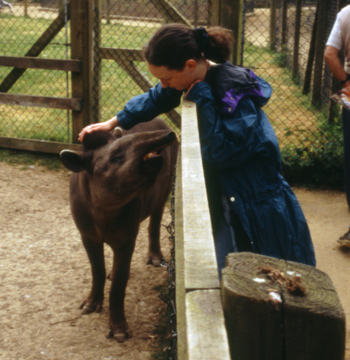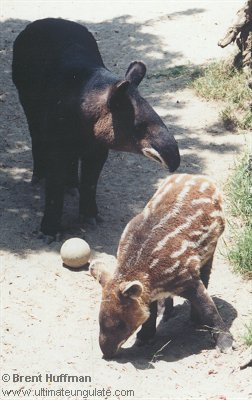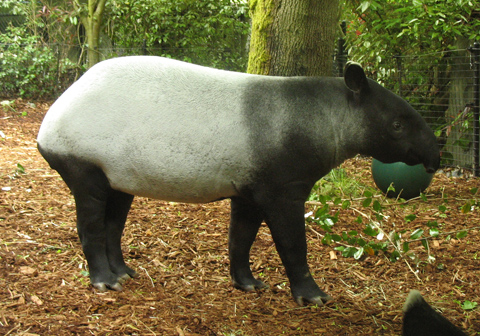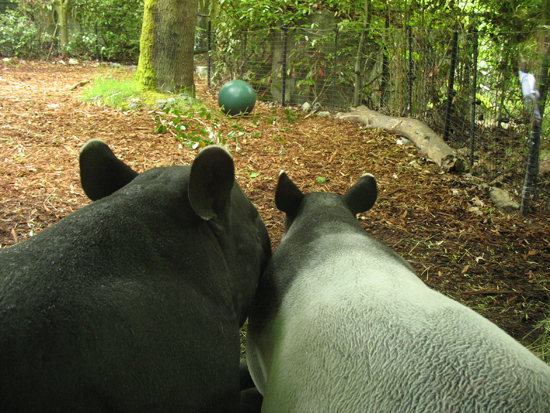|
 ABOUT TAPIRS
ABOUT TAPIRS 
Kelang, the female Malayan tapir at the Woodland Park Zoo in Seattle
Tapirs are large forest mammals most closely related to rhinoceroses and horses, weighing between 350 and 900 pounds depending on the species and sex. They have proboscises, sloped backs, and stubby little tails. They have four toes on each front foot and three on each back foot, and all types of tapirs have white tips on their large rounded ears. As calves, all tapirs are brown with white spots and stripes - they're often described as watermelons with legs - providing them with camoflauge in the dappled sunlight of the forest. They are vegetarians (they're especially partial to bananas), enjoy swimming, and are largely, but not exclusively, active in the evening and at night. All tapirs are in danger of extinction.
Milton, one of the Baird's tapirs at the Franklin Park Zoo in Boston
There are four species of tapir worldwide, three found in the Americas and one found in Asia. The Baird's tapir lives in Central America and northern Colombia and is the largest New World species. It has greyish-brown fur, cream-colored cheeks, and a small dark spot on each cheek.
Me, patting a Brazilian tapir at the Cotswolds Park when I was 14
Brazilian tapirs, also known as lowland tapirs, are found in jungles throughout South America, from Colombia to northern Argentina. They have brown coats and bristled crests running from their foreheads to their backs.
Adult female and 5-month-old mountain tapirs at the Los Angeles Zoo
Photo © 1999 by Brent Huffman of www.ultimateungulate.com
The mountain tapir is the smallest type of tapir and also the most endangered. Unlike the other kinds of tapirs whose coats are very short, mountain tapirs have slightly shaggy fur, even before they get their adult coats. This helps to keep them warm in the higher elevations of the Andean cloud forests where they make their home.
Rindang, a female tapir at the Woodland Park Zoo, about 10 months old
The tapir after whom this site is named is the Malayan tapir (Tapirus indicus), the largest member of the genus and the only one native to Asia. Malayan tapirs are easily identified by their markings, most notably the light-colored “saddle” which extends from their shoulders to their rump. The rest of their hair is black or charcoal grey, except for the tips of their ears.
Malayan tapirs grow to between 6 and 8 feet (1.8 to 2.4 m) in length, stand 3 to 3.5 feet (90 to 107 cm) tall, and typically weigh between 550 and 700 pounds (250 to 320 kg), although they can weigh upwards of 900 pounds (410 kg) on occasion. The females are usually larger than the males. The Malayan tapir has rather poor eyesight but excellent senses of smell and hearing.
The gestation period of the Malayan tapir is approximately 400 days, after which a single offspring, weighing around 15 pounds (6.8 kg), is born. Weaning occurs between six and eight months of age, at which time the babies are nearly full-grown, and the animals reach sexual maturity around age three. Breeding typically occurs in April, May or June, and females generally have one calf every two years. Malayan tapirs can live up to 30 years, both in the wild and in zoos.

Rindang, one month old, at the Woodland Park Zoo
Malayan tapirs are primarily solitary creatures, marking out large tracts of land as their territory, though these areas usually overlap with those of other individuals. Tapirs mark out their territories by spraying on plants, and they often follow distinct paths which they have bulldozed through the undergrowth.
When threatened or frightened, tapirs can run quickly, despite their considerable bulk, and they can also defend themselves with their strong jaws and sharp teeth. Malayan tapirs communicate with high-pitched squeaks and whistles. They usually prefer to live near water and often bathe and swim, and they are also able to climb steep slopes.
The Malayan tapir was once found throughout the tropical lowland rainforests of Southeast Asia, including Cambodia, Indonesia, Laos, Malaysia, Myanmar (Burma), Thailand, and Vietnam. Due to human activity, especially deforestation for agricultural purposes as well as poaching and illegal trade, its habitat and numbers have decreased in recent years.
The species is officially recognized as “Endangered” under the IUCN Red List of Threatened Animals. The exact number of Malayan tapirs left in the wild is unknown, but some scientists estimate that there are less than 4,000 individuals left in the wild. Tapirs are rarely hunted by animals other than humans, because their tough skin and good defenses make it difficult to harm a healthy adult. Leopards and tigers may attack calves, old adults, or ill individuals, but for the most part the threat to tapirs comes from humans.
Kelang and her daughter Rindang at the Woodland Park Zoo
There is a lot of great information about tapirs on the web. Here are some links if you're interested in finding out more about these lovely creatures or want to know more about what you can do to help them.
- The Wikipedia article on tapirs: I'm partial to it because I wrote a lot of it.
- The Ultimate Ungulate Page; "Your guide to the world's hoofed mammals." You can find tapirs in the odd-toed ungulate (Perissodactyla) section.
- The Tapir Gallery: Put up by the Tapir Preservation Fund, this is a huge site all about tapirs with pictures, information, and conservation efforts.
- The Tapir Specialist Group: Affiliated with the World Conservation Union (IUCN), this site has yet more information, including tons of stuff on saving these four endangered species.
- En Español, Proyecto Danta: Info, articles and pictures on South American tapirs as well as other Venezuelan and Andean species, brought to you by AndígenA, a non-profit conservation organization. (I can't read a lot of it, because my Spanish is pretty rusty, but it could be useful to you.)
- In German (which I really don't speak), 4Tapirs: A site created by Dr. Stefan Seitz, a tapir researcher, with lots of information about tapirs in zoos (at least, that's what I gather).
- Tapir Sounds: Turn on your speakers and hear a Brazilian tapir from the Hagenbeck Zoo in Germany chirp!
I have created a set of spreadsheets to record information about tapirs in zoos across the world. The spreadsheets can be viewed in Google Documents. If you have additions, corrections, or questions about the spreadsheet, please feel free to email me at tapir [dot] spreadsheets [at] clearhive [dot] com.
ALL CONTENT COPYRIGHT 2012 BY SASHA KOPF UNLESS OTHERWISE SPECIFIED
PHOTO BY BRENT HUFFMAN USED ACCORDING TO POLICIES LISTED ON WWW.ULTIMATEUNGULATE.COM











